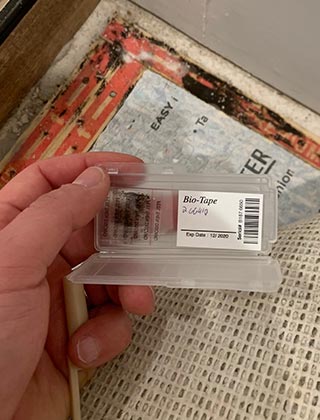MENU

Sometimes you can't be sure if the brown spot on the wall is mold or not. With surface sampling, we collect samples directly from a surface where mold growth is suspected. Mold testing confirms whether it is mold and provides written documentation of what was found.
Surface samples are taken directly from an area of suspected or known mold growth. This type of testing is often done together with air sampling, though it can also be done alone.
The samples are dispatched to an independent testing laboratory, where any mold strains are identified.

A common question in the complicated world of mold tests is how to tell if that strange stain or color change really is a sign of mold growth. We at O2 Mold Testing have been studying the science of finding mold for twenty years and use a variety of surface sampling methods.
Surface sampling is more than just a way to find mold; it's also a scientific way to learn about the world of fungi, which is invisible but very important.
Most of the time, microscopic study is the best way to look at surface samples because it directly sees fungal growth instead of just counting spores. Culturing can help with specific identifications, but it might not always give a true picture of the area that was tested.
Surface sampling, which is often thought of as a research tool in the world of microbes, has a number of benefits:
Surface sampling has some problems. But surface sampling has its limits, just like any other method: signs of poor air quality. There is no direct link between living materials on a surface and air quality.
When it comes to gear, keeping things simple is important. There is no need for any special tools for direct microscopic studies.
At O2 Mold Testing, we mix professional know-how with a bit of interest and participation. We don't just look for growth; we find out what each spore's secret story is. Get in touch with us if you need detailed and accurate mold sampling services. We can help you see things more clearly inside.